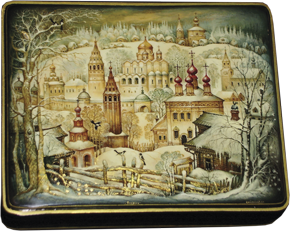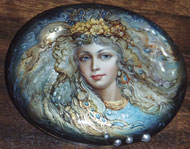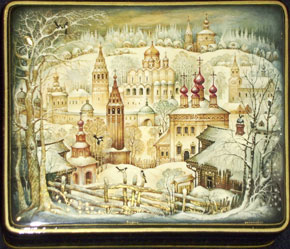THE MAGIC OF RUSSIAN LACQUER BOXESLacquered papier-mache boxes have been an Asian form of art for centuries. But savvy international collectors know that the technique has been taken to Russia and made into one of the country's most beautiful collectibles.
I'm using my large magnifying glass to closely examine one of my favourite Russian boxes. It is a small – 12 cm by 8 cm – box, made of lacquered papier-mache, and then hand-painted by an incredibly gifted artist. It is a magnificent, if miniaturised piece of exquisite art. The painting is almost unbelievable – so fine that some of the lines have been painted with a brush that only has two or three squirrel hairs. And the detail is absolutely superb. No wonder that of all the things that I have ever collected, Russian boxes are by far my favourite!
Most of us have collected one things or another during our lives. Some people collect stamps, others baseball caps, yet others have a passion for vintage cars, or frogs, or beer steins. But arguably the most popular collections are in the art field.

If one becomes interested in Russian lacquer boxes, it is immediately apparent that a good box is the work of a true artist – one who has spent many years perfecting a skill that 99 % of the rest of us can only wonder at and admire. My own collection of Russian boxes is such that I always have an illuminating magnifying glass handy. And if I ever feel depressed or worried, I can escape into the world of magic by sitting down for 15 minutes and looking at my collection.
It is not only a constant source of joy and wonderment to me. I am well aware of the fact that, 30 years down the line, these boxes will be museum pieces and today's outstanding Russian lacquer boxes may no longer be affordable. Right now is the perfect time to start a collection, because no other art form is better value for money. If you choose wisely, your Russian lacquer boxes will not only give you enormous pleasure, but will also be wonderful heirlooms to pass down to future generations.

During my research on these boxes, it was interesting to discover that a Russian venture to produce these had been set up as early as 1798. Its founder, Piotr Korobov, learnt the process from a German manufacturer, Johann Stobwasser, whose predecessors had brought the lacquer-box manufacturing art to Europe from Japan.
Once the art of making the blanks was brought to Russia, a number of icon painters switched to painting these lacquer boxes. They soon caught the imagination of the Tsars and the rich and famous leaders of Russia. Subsequently the Lukutin family took over this first factory with its traditions, and later village collectives carried on these teachings.
Rising demand persuaded the box factories to expand to four villages and set up schools there, and each village soon developed its own style. The very best painters also became teachers, and their work gained an international reputation.
During the Communist era, artists had to switch from religious themes to Russian fairytales and designs extolling the virtues of Communism, but after Gorbachev artists were given complete freedom to paint whatever themes they chose, and the art rose to new heights.
I was not surprised to find that the painting schools in the four major box villages, Fedoskino, Palekh, Mstera, and Kholui, each of which now have their distinctive styles, were turning out large numbers of similar-looking boxes while training their students. These boxes are available on the market as interesting but not remarkable souvenirs of a tourist's visit to Russia.
But there are also collector-quality boxes, created by some of the finest artists and craftsmen in Russia (many of whom are also teachers in painting miniatures). These boxes are individually designed and then painted by incredibly skilled and creative master craftsmen. They take between a month and 6 weeks to complete.
So are there any traps in collecting? Yes, there are. You need to have some understanding of what you're looking at, and whether the box in your hand is a wonderful work of art or a mass produced souvenir with little commercial or artistic value. If you visit Russia on a cruise ship or on a tour you will see tourist booths of lacquer boxes at prices starting at around US$ 30. Look closely however, and you will see that what at first glance looks like a painted scene on the lid is really a transfer or paper print, glued on and lacquered-over to superficially look like the real thing. It's a great present to take home to the kid next door who has been minding your dog while you're on holidays, but has no other value above that.
The next level of 'souvenir' boxes will be genuinely hand-painted, but by students just starting to learn the craft. These might cost you the Rouble equivalent of US$ 50–US$ 100, and again they have no collectors' value. At the painting schools of the Russian villages, students are given set designs to copy while they are learning. And so a class will turn out hundreds of boxes of the same design. Though each is painted by a different student and to varying quality standards, you will just be getting a fairly ordinary box.
In Moscow and St. Petersburg there are a vast number of galleries and souvenir shops that sell boxes ranging from average to superb, but the prices will, quite frankly, be up to four times those you should really be paying. So how do you know what to buy? And how do you know how to get top value?
GETTING STARTED
The first step I recommend is to buy an Englishlanguage book on Russian boxes – I believe the best is Russian Lacquer Painting–the 21st Century by Ludmila Pirogova. This lady is the lacquer miniature Department Chief of the All-Russia Museum of Applied and Folk Art in Moscow and no-one in Russia knows more about this subject, or explains it better. (There are also other books on the subject in my collection now, but this book is in my opinion the finest available.)
Having read the book and fallen under its spell, I started hunting for the painters mentioned in it. They are the very best that you can find in Russia, and their works come up for sale regularly around the world. My advice to you is this – if you can afford the time and expense, fly to Moscow and spend a little time, looking closely at every box that you see and like, writing down the name of the painter and the price asked.

When I started and knew less about where to source the best boxes, I bought some in Russia at prices which I now know were excessive. I also bought some in San Francisco and Western Europe, but now realise that these too were considerably overpriced. And then I found an amazing dealer in Russia – Alexey Yefanov, who has been my source of boxes ever since.
Once you become serious about your collection you will find Alexey extraordinarily well-connected with the very best painters in each of the Russian villages famous for lacquer boxes. And the box-selection on his website russinlaquerart.com is truly awesome. Here you will find artists like Shapkin, Kozlov, Smirnova, the whole Molodkin family and many, many others featured in Pirogova's book. If you are planning on building a serious collection, Alexey may – as he did with me – take you to one or more of the villages to see how the boxes are made, and then introduce you to a number of the most famous artists in Russia. You will be amazed how modestly these fabulous artists live, and to what extent you will be made welcome.

And don't miss the lacquer-box museums in these villages. Because this is where you will find the romance and history of each villages painting styles, and will discover that some of the most famous painters whose work you are collecting are, or have been, teachers at the village school at some stage. I personally never buy boxes at the museums or schools' shops because the boxes are invariably stamped with the name of the school, even if they have been painted by the masters while they are teaching there. The schools are now run down, having lost their government subsidy, so often overcharge on the boxes they sell, and rarely have the top artists for sale.
Buying from a reputable, well-priced supplier provides the peace of mind that one is buying the 'real thing'. And you will be pleasantly surprised to find that, while a top Shapkin box might be priced at over US$ 7,000, other boxes by absolutely first-class artists featured in Pirogova's book cost less than US$ 1,000 and slightly newer and lesser-known painters can be found at way under US$ 500. So you don't have to break the bank to start a collection.

Once you have started with this hobby I would suggest that you 'mix and match' artists and villages. A serious collection should contain boxes from all the villages. But you also may find one or two artists whose work you fall in love with – for me the works of Shapkin, Kozlov, Isaev, Smirnova and all the Molodkin family are absolute gems, and though they are more expensive than most, they should always hold their value because these painters are true masters. Even if you are not able to go to Russia, order the book first, study it carefully and then start collecting, box by box. In today's art world and during today's difficult world economy, a Russian lacquer box collection will prove the best value and most affordable entry into the world of art collecting. Every one you acquire will translate into additional wonderment, delight and serendipity. And what could give you more than that?
Text and photos Walter Glaser
|
 +65 6696 7068
+65 6696 7068
 info@meridian103.com
info@meridian103.com
 PDA
PDA
 +65 6696 7068
+65 6696 7068
 info@meridian103.com
info@meridian103.com
 PDA
PDA

I am looking for more info , about a lacquer I bought,
I think it is made before 1917 in St Petersburg .
Can you give me adress or can you help me if I send some picture from the box.
Regards Kees Jan Post
Kees Jan Post, 2014-12-08